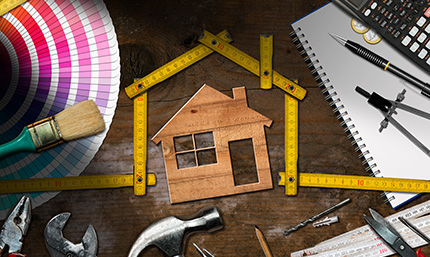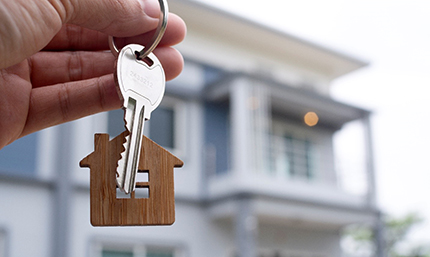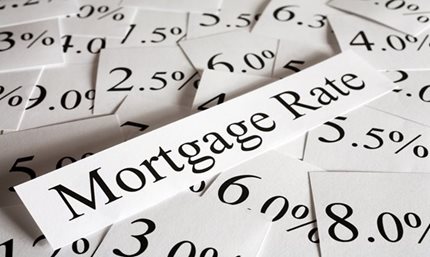News & Tips
10 Steps to Buying a House for the First Time in Florida

Are you dreaming of moving into a home? If you’re new to home buying, it’s natural to wonder how the home-buying process works. From finding the perfect one to financing a home purchase, you may feel a little overwhelmed thinking about it. Not to worry, we’ll take the mystery out of the process of purchasing a home in this step-by-step guide to buying a house for the first time in Florida.
Step 1: Determine your motivations for buying a house.
The first thing to do before buying a house is to consider why you want to be a homeowner. After all, a house is a large purchase and often a long-term commitment. Perhaps you’re looking for housing that’s in a better location for your job or family or you need more space. For many, homeownership brings a lot of pride and joy, especially knowing you’re building equity! Check out our other article on renting vs. buying a home to help you decide which is best for you right now.
Step 2: Evaluate if you’re financially ready to buy a home.
Let’s walk through the steps of getting your finances in order before buying a home:
1) Check your credit score
Your credit score is one of the biggest factors that determines your home loan’s interest rate. A minimum credit score of 620 is usually the requirement for most mortgages (but varies by loan type). Your credit reports determine your score—you can check your credit reports with TransUnion®, Experian®, and Equifax® for free once a year at AnnualCreditReport.com, and be sure to request that they correct any errors. At Space Coast Credit Union (SCCU), you can see your FICO® Score for free in your Online Banking account. Learn more about building your credit score here.
2) Calculate your debt-to-income ratio.
Home loan lenders will also look at your debt-to-income (DTI) ratio, which should ideally be 45% or under. Our debt-to-income calculator and worksheet can help you determine yours. Additionally, lenders often look at the last two years of your work history to check that your income is stable (generally this will involve pay stubs, W-2s, and/or tax returns).
3) Determine your monthly mortgage budget
Ideally, as a rule of thumb, you don’t want to spend more than 30% of your gross income on your monthly mortgage payment. What down payment and interest rate will help you stay within that guideline? Our mortgage calculators and our home loan estimator tool can help! Be sure to factor in the costs for homeowners insurance and property taxes. Some neighborhoods also require an HOA (Homeowners Association) fee too.
4) Save up for upfront costs.
If you haven’t already, set aside money for closing costs (typically 2.5%-3.5% of the home’s purchase price in Florida), and make sure your budget allows for any repairs. While it’s a good idea to save 20% for a down payment to avoid private mortgage insurance, you should have a separate savings account with 3-6 months’ worth of expenses for emergencies.
Step 3: Explore your home loan financing options.
Once you’ve determined you’re in a good place financially for a home loan, it’s time to compare several mortgage lenders. Check out their interest rates, mortgage products, service ratings, borrower qualification requirements, and any fees they may charge. Generally, credit unions like Space Coast Credit Union will have lower home loan interest rates and fees than banks will.
You’ll find a variety of home loan types that lenders will offer—but which option suits your needs and qualifications? Here are some helpful questions to get started:
- Are you looking to stay in your home for a significant number of years? The most common type of home loan is a conventional fixed-rate loan (requires a down payment as low as 5%16), which allows you to plan for a consistent principal and interest payment for the life of the loan. (Keep in mind that real estate taxes, homeowners insurance, and, if required, private mortgage insurance are also factored into your payment, and may change over time.)
- Are you not planning for this to be your long-term home? Your lender may offer an adjustable-rate mortgage with a rate that’s lower than the fixed rate offering for the first 3, 5, 7, or 10 years of your loan. Even if the rate increases in years four and five on your loan (get clarity on how much it can increase each year), it very well may be better for you to choose the adjustable-rate loan. Ask your lender to help you calculate this for your specific situation.
- Don’t think you can put down 20% of the home’s purchase price? An FHA loan may be for you, especially if you have less-than-perfect credit. FHA loans only require a down payment as low as 3.5%16. In some cases, a No Down Payment home loan option may be a good fit for you.
We also offer VA loans, Hero Home Loans, and a No Closing Costs option. Check out our Ultimate Guide to Mortgage Loans for more details about all the loans we offer.
Step 4: Get pre-approved for a home loan.
Not only will a pre-approval letter provide you with documentation showing sellers and real estate agents that you’re serious about buying, it will also help you get a better idea of the price range you can afford. In fact, many realtors will not consider an offer without a pre-approval letter.
To get pre-approved, you will start by submitting a mortgage application. A loan officer will look at your credit history, income, assets, debts, etc. The lender will run a credit check and verify other documentation prior to providing a pre-approval letter with a loan amount.
If you’re shopping several lenders, don’t worry too much about the credit check. Suppose several mortgage lender requests show up on your credit report within a relatively short time (usually 45 days). In that case, they are viewed as one shopping experience and won’t count as individual credit inquiries. Most pre-approvals expire after 60-90 days, but you can provide updated information if you need a new pre-approval letter. SCCU home loan pre-approvals are valid up to 90 days—woohoo!
Keep in mind that a pre-approval is not a final loan decision. Once you’ve found a property, the lending team will request a property appraisal to ensure the property value is in line with the loan amount, and re-verify all of your paperwork one final time before closing.
Step 5: Hire a real estate agent.
Experienced real estate agents can help you navigate the current market, find houses in your price range with your “wants” and “needs,” negotiate with the sellers on your behalf, work through any challenges, and recommend home inspectors. Plus, real estate agents have access to a private database of properties for sale, and they can help you stress less throughout the process.
Step 6: Go house hunting!
For many people, this part is the most fun, as you attend open houses, check multiple listing services, and work with a real estate agent to find the house of your dreams. Decide on the top must-haves for a house, use filters while searching, and list the houses that you’d like to see.
It’s best to see homes in person—professional pictures capture the home in the best light possible, but they don’t embody the breadth of the space, good/bad smells, and any nooks or crannies that are cause for concern. So, if possible, see the home in person! Plus, you’ll want to get a good feel for the neighborhood (neighbors/traffic noises/schools/retail/etc.).
Step 7: Make an offer on a house.
In this stage, you’ll offer the seller a certain dollar amount for the house. Your real estate agent will help you prepare the offer package. Be careful to include relevant contingencies in your purchase agreement, such as the need for the house to appraise for a certain amount, for the home inspection to go well, and for your loan to be officially approved for the particular property.
In most cases, you’ll also need to provide earnest money (often 1% of the purchase price) to show you are committed to the process, which usually goes into an escrow account. Learn more about how escrow accounts work here. Once your loan is approved, the earnest money you paid becomes part of the down payment. If you change your mind on getting the house (for a reason not listed in the contingencies), the seller could have a right to pocket the money.
Step 8: Get a home inspection and make any negotiations.
A home inspection will help you and your lender decide if the house is a worthy investment. The inspector will uncover any potential major or minor issues. In some cases, you’ll be able to have the seller fix any issues on their dime, reduce the purchasing price, or purchase any warranties. Your real estate agent can help you with this process. Any major structural issues could cause the lender to not approve the loan, so it’s important that you have a home inspection contingency clause.
Step 9: Complete the mortgage application process.
When you’ve found a home and made an offer, it’s time to get the final loan approval. This is a more detailed version of the pre-approval stage, where the lender will often request:
- Updated financial statements: It’s best if you submit the documents in a timely manner to avoid any delays. It’s very important not to incur any new debt between obtaining a pre-approval letter and closing on the house. Making a large purchase on a payment plan or running up credit cards can affect your final ability to qualify for a mortgage or get the best rate.
- Appraisal: As mentioned earlier, your lender will request an appraisal to ensure the home’s value aligns with the seller’s asking price. Don’t be alarmed if you get requests from processors or underwriters for additional information or clarification—it’s a normal part of the approval process.
- If the appraisal matches your offer price or is above your offer price (lucky you!), then you should be clear to close.
- If the appraisal comes in low, your options often include: paying the difference, re-negotiating with the seller, or requesting a new appraisal if you believe it was incorrect.
- Homeowners Insurance: In this stage, you’ll also need to shop around for homeowners insurance. Learn more about SCCU’s home insurance partner. Keep in mind that most policies don’t provide coverage for flood damage, so if your house is in a flood zone, it’s a good idea to add flood coverage to your policy.
With your final approval in hand, you’re ready to close on financing your new home!
Step 10: Close on the house and get the keys!
A few days before the closing, you’ll receive a closing disclosure. The disclosure will detail the final terms of your loan, as well as costs associated with the closing and who will pay them. This will give you a chance to review all terms and closing costs to ensure that everything is in order and you know how much money to bring to closing. On or near the closing date, you’ll usually do a walk-through of the house with your real estate agent (usually to ensure that the home meets any disclosure requirements and that the seller fixed agreed-upon issues).
Your lender will finalize the loan and provide funds to the seller. The lender is named as a lienholder on the property. Expect to sign a lot of papers, including the closing disclosure. When the loan closes, then the title of the home will officially be in your name and the property will be yours! Congratulations!
SCCU Home Loans
Don’t worry if the home-buying process seems confusing! With Space Coast Credit Union, the third-largest credit union in Florida, you’ll be working with a qualified mortgage team who can answer all of your questions. Whatever stage you’re in, we’ll be glad to discuss your home loan financing needs and review your options. One of the benefits of working with an institution you trust for your mortgage is that it clears your mind to focus on the fun stuff, like where to put the sofa!
























.jpg?width=430&height=257&ext=.jpg)




